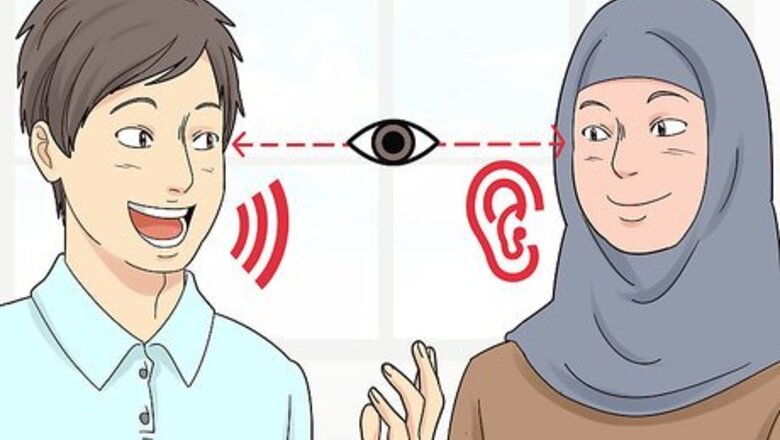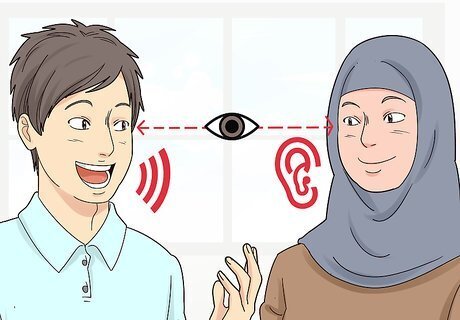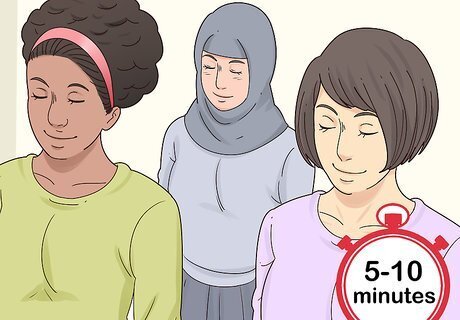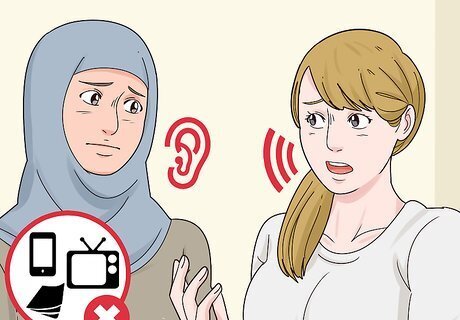
views
Role-Playing

Practice listening without interrupting. If a person rushes to respond or share their own opinions, they stand in the way of empathy. Hold mock conversations in which one person talks while the other person hears them out completely. Encourage the listener to turn to face the speaker and make eye contact. The listener should be trying their best to understand what the other person is saying, not simply listening to reply.

Paraphrase what others say to verify understanding. Those learning empathy need feedback to determine if they understand others' messages during communication. Saying what the person said back to them in a different way helps them double-check that they got the right message. Paraphrasing may sound like, “From what I'm hearing, you seem very shocked and upset about the results of your doctor's exam. Is that right?” If the message was not received correctly, the speaker can try to relay it again so that the listener understands. Paraphrasing can also be taught in practice situations to help them feel confident doing it in real-life conversations.

Work backwards to read others' nonverbal and verbal cues. Identifying what someone is feeling can be challenging in the moment. To build the skill, start at the end: with the emotion you think the person felt. Then, reflect back and analyze other details, like facial expressions, body language, tone of voice, and the actual words that were said. For instance, if a wife guessed that her husband was angry, she might work backwards and recall that his arms were crossed, he was pacing, he had a sneer on his face, and his speech was overly sarcastic. Noting these details can help her read future nonverbal and verbal cues more easily.

Imagine stepping into the shoes of others. Help adults learn empathy by breaking down different scenarios and reflecting on the experiences of the people involved. This may work best by using scenes from popular movies or TV shows. For instance, a scene from a movie may portray two friends fighting. Have two people role-play the scene and discuss what each character may have been thinking and feeling, and what cues help you figure that out.

Practice loving-kindness meditation. Have everyone start by spending 5 or 10 minutes breathing deeply and generating good vibes about themselves. This might include silently repeating affirmations, like “I am worthy," or simply envisioning giving oneself a warm hug. In subsequent meditation sessions, they can start focusing on a friend or family member. Radiate positive thoughts towards that one person for the full exercise—just for about 10 minutes. After focusing on loved ones for a few sessions, they can then progress to radiating good vibes to a virtual stranger, such as the nice barista at Starbucks or someone they heard about on the news. Loving-kindness helps connect with the deeper human side of oneself and others, increasing a person's ability to feel empathy.
Making Connections

Get curious about strangers. Plan an outing where everyone sits down at coffee shops, cafes, or park benches and simply observes the passersby. Have them make up stories in their heads about what the people might be doing, thinking, or feeling. When people are really caught up in their own small worlds, their capacities for empathy are limited. When they expand their focus to the world at large (including strangers), they become more capable of feeling deeply for others. If coming up with simple stories about stranger's lives doesn't come naturally, encourage them to use body language, style of dress, or actions to help build the stories. They can also draw on stories they know, such as in movies or books, as a foundation for what they think strangers are doing.

Spot commonalities. Differences separate, while similarities bring people together. Talk to others about the different people in their lives—everyone from their kids’ teachers to the mail carrier. Make a list of the things they might have in common with these people. If they have trouble spotting commonalities, suggest that they start with the larger, more obvious things that can forge connections. For example, a mom may like the same color as her child's teacher. A neighbor may root for the same sports team as the mail carrier. As you practice connecting more through bigger items, you can eventually move toward smaller, more personal things.

Use mindfulness during daily activities. Encourage those you are teaching to be mindful about everything they do for a day, particularly how others may play into their daily activities. Getting in touch with the human side of basic activities can help them build stronger connections with others. For example, while drinking their morning tea, they may think about the farmers and workers who harvested the leaves. While driving, they may consider the mechanic who gave their car a tune-up or the person who washed it.

Read fiction to connect with others' experiences. Becoming immersed in fictional stories has been shown to increase one’s capacity to understand and relate to other’s experiences. Challenge everyone to get lost in a fictional story and really connect with the lives of the characters.

Volunteer more often. Inspire those you are teaching to take positive action in their local communities. Suggest some of the following volunteer opportunities to the adults you work with: serve in a soup kitchen, dedicate time to an important charity, or read to at-risk children at the library. Working with and helping others from a variety of backgrounds can help people see the shared humanity in others who seem different on the surface. As a result, this cultivates stronger empathy for people in general.
Using Empathy in Your Own Life

Give people your full attention. Distractions are one of the most common obstacles to effective empathy, so remove them whenever possible. Silence your phone, turn off the TV, put down the magazine, and truly engage with the person you are talking to. Distractions aren't just cellphones and TV, though. You can also become distracted mentally or physically, such as when you are worried or hungry. Attend to your needs before starting a conversation, so you can be fully present with others.

Share your emotions when you connect with others. Being vulnerable with your own thoughts and feelings is a call that allows others to exercise empathy. When you are talking to others, make an effort to use feeling words. This helps clue them into your emotional state. For instance, you might say, “I was shocked by the news of the accident” or “I’m angry that you didn't consult with me first.”

Respond appropriately to the concerns of others. Is someone around you in need of empathy? If so, use open body language that fosters a connection, make occasional eye contact, and soften your voice. If you have a deep relationship with the person, you might hold their hand, caress their back, or hug them. Just make sure you are aware of the other person's personal boundary needs before you try to make physical contact with them. Sometimes, you may get the call to express empathy towards others, but not know how to do it correctly. If this happens, simply be present with the person—just be there.

Find specific ways to lend a helping hand. You can inspire others to be empathetic by taking action when others are in need. Rather than just standing on the sidelines (or expecting the person to request help), think of actionable ways you can offer assistance. For example, if a friend is stumped about a breakup, try to get them out of the house to see a movie or go to the spa. If a family member is struggling with mental illness, offer to accompany them to therapy sessions or support group meetings.




















Comments
0 comment